Authentic Cornish Pasty Recipe
This post may contain affiliate links. See my disclosure policy.
The national dish of Cornwall, England, this authentic Cornish Pasty recipe features savory flaky pastry pockets filled with beef and vegetables. Cornish pasties have a long and fascinating history and are the very essence of comfort food. Learn how to make a Cornish pasty the authentic and traditional way.
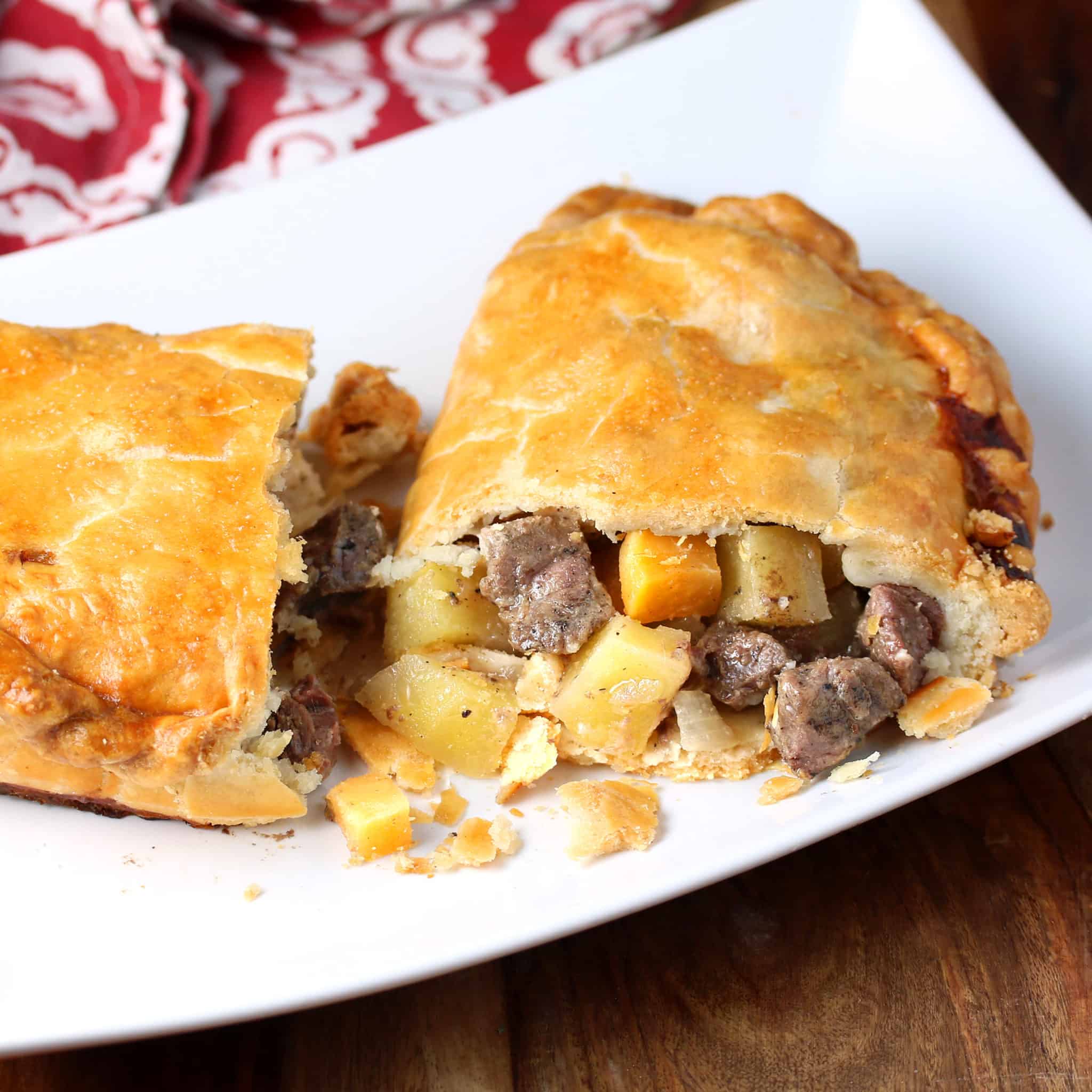
I love Great Britain. I lived in Cambridgeshire, England for nearly 7 years and my husband spent 2 years in Liverpool and north Wales. We’re both Anglophiles through and through and go back at least once a year for a visit with our kids. We love every area of Great Britain and it’s hard to pinpoint a favorite area. But Cornwall holds a very special place in our hearts and no matter where else in England we’re visiting, we always make time for a visit to Cornwall.
A Brief Cornish Family History
We love Cornwall not only because of its striking natural beauty, rustic charm and rich culture, but also because it’s home to my husband’s namesake ancestors, the Killigrew family (later changed to Killebrew when his great+ grandfather immigrated to the U.S.). The Killigrews were landed gentry and one of the most prominent families in Cornwall. They founded the port town of Falmouth, built and lived in Arwenack Manor, and were the royally appointed de facto captains of Pendennis Castle. We always look forward to a return visit to these family sites including St. Budock church where the Killigrew family held front row seats, are buried beneath the floor in front of the altar, and where a well-known painted wall edifice stands depicting Todd’s great+ grandparents kneeling in prayer towards each other.
I can’t claim as close (or as impressive) of an association to Cornwall as Todd, unfortunately. But I do have a great+ grandmother from Scotland (wife to an admiral who regularly sailed down to Cornwall on business) who died and is buried in Cornwall. And it’s like I always say, if you’re going to die (as most people tend to do), there’s no better place to do it than in Cornwall.
With our close connection with and love for Cornwall, we also feel a close kinship with its traditional foods, the most famous of which is the Cornish pasty, considered the national dish of Cornwall.
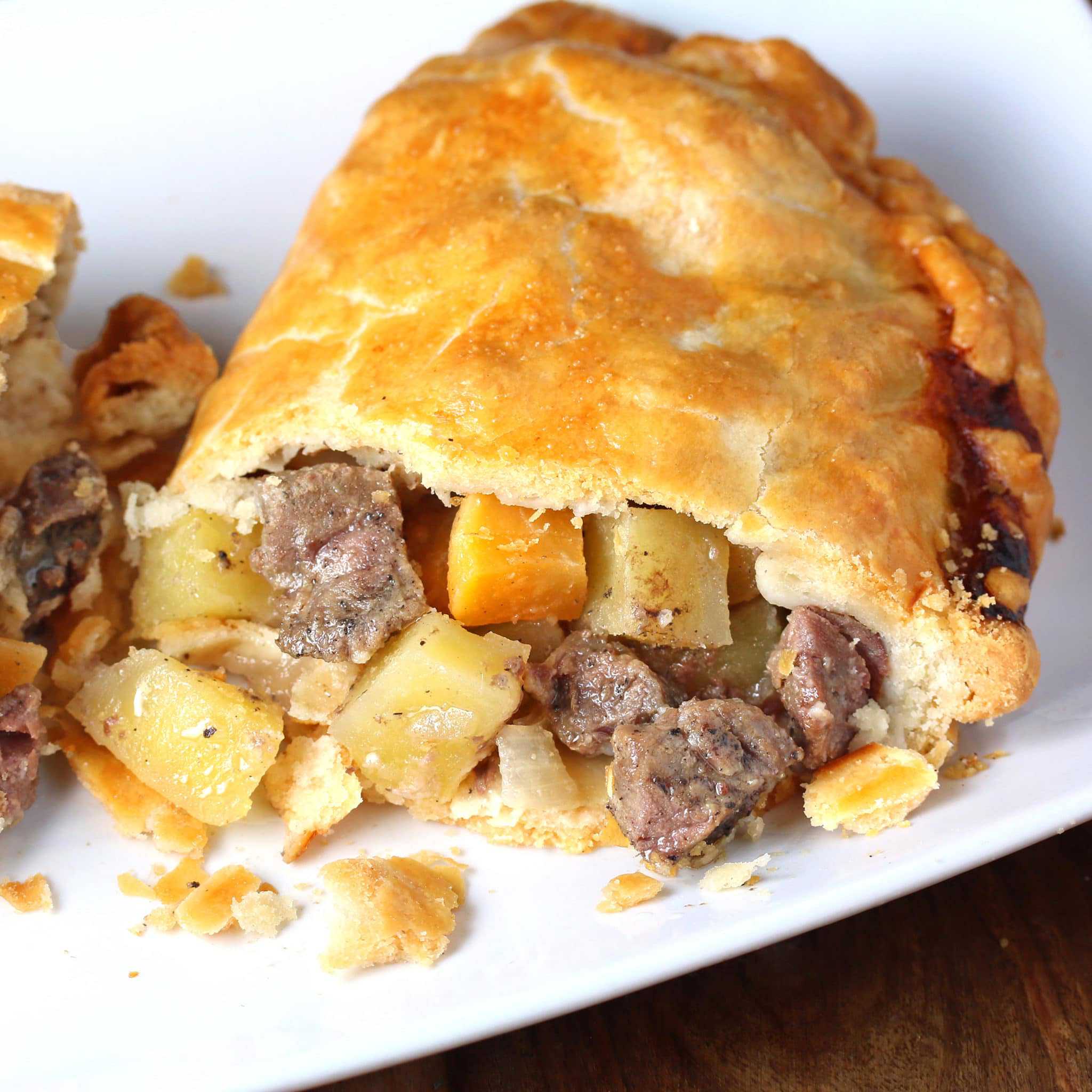
What is a Cornish Pasty?
A Cornish pasty is a turnover-shaped baked shortcrust pastry filled with beef and vegetables. The edges are sealed by crimping them in characteristic Cornish fashion.
In 2011, Cornish pasties were given both a Protected Designation of Origin (PDO) and Protected Geographical Indication (PGI) status, which means that in order for these pasties to be made commercially and bear the name “Cornish pasty”, they have to meet very specific requirements. These requirements are as follows:
- They have to be made in Cornwall.
- They can only contain beef, potato, Swede (rutabaga), onion, salt and pepper. No other meat, no other vegetables, no other seasonings allowed.
- The ingredients must be raw when the pasties are assembled and then slowly baked to produce the traditional Cornish pasty flavor and texture.
- The edges of the pasties must be sealed by crimping them in traditional Cornish fashion.
No culinary license allowed here and any deviations from these parameters will land you in stocks at the market square for public shaming. Well, that may be a stretch. But you will incur a fine.
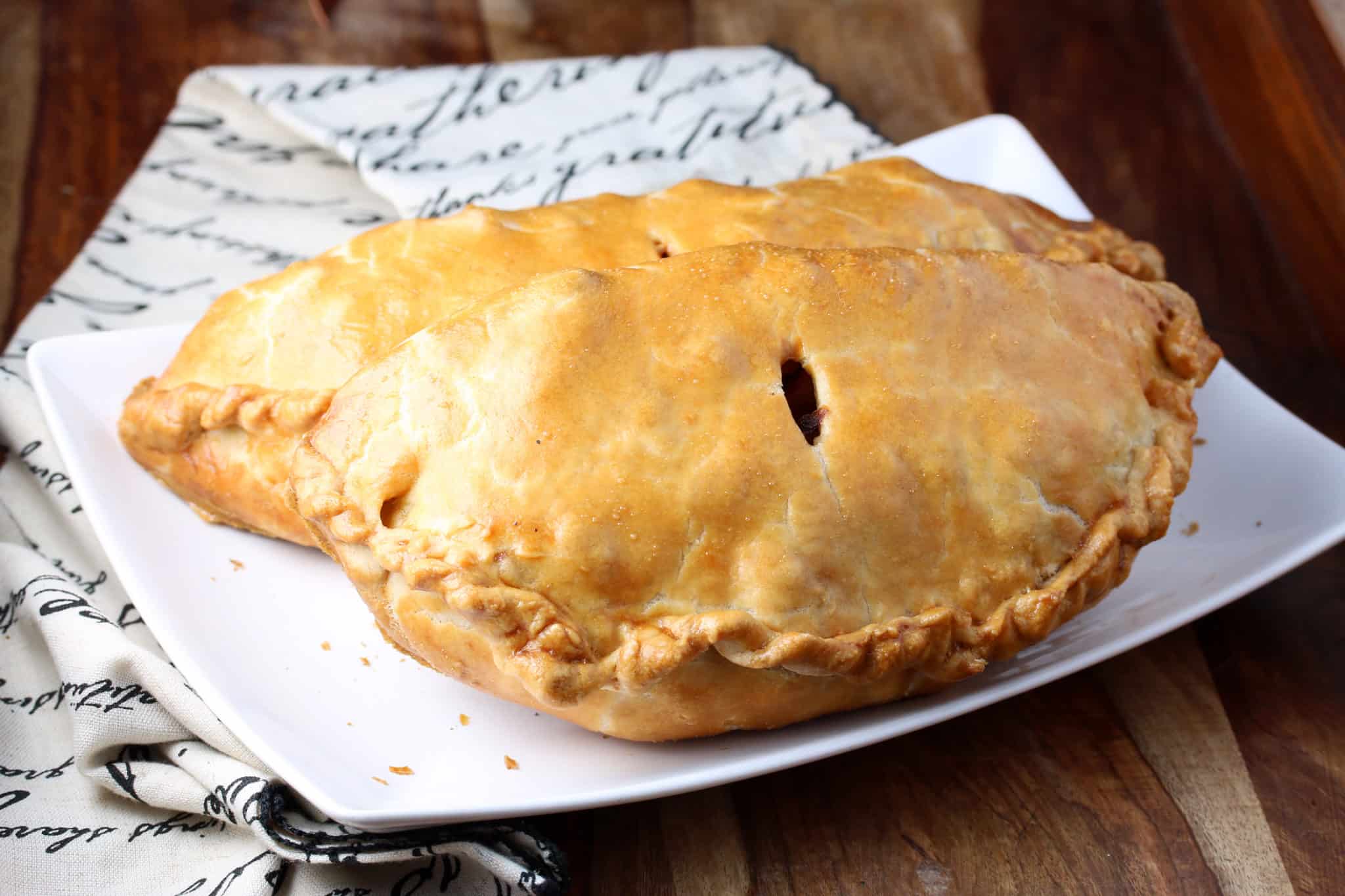
The Origin of the Cornish Pasty
The Cornish pasty has a unique and interesting history that goes back centuries. Cornwall had the biggest tin mining and one of the biggest copper mining industries in the world and the pasties were originally developed for Cornish miners. These men worked deep underground and needed a lunch that would meet the demands of their work environment. The thick shortcrust dough and dense filling would stay warm for several hours until lunchtime or could be easily reheated over the flame of an oil lamp.
The pasties were sealed with a thick crimp to hold in the contents and to provide something the miner’s could hold onto while eating the pasty. In this way their dirtied fingers, which could often contain traces of arsenic, wouldn’t contaminate the rest of the pasty. The crimped edge was sometimes extended out to form a little dough handle they could hold onto and then discard when they were done eating.
The filling was a hearty one that provided needed sustenance and the pasty was compact enough that it could easily be carried in a small lunchbox down the mine and eaten without utensils. Some historians also believe that the miner’s initials would sometimes be engraved in the dough at one end of the pasty so that if the miner didn’t finish it in one sitting they could easily identify it as their own.
Thoughtful wives would even take their ingenuity a step further and make pasties that were divided in two sections: One half would contain the savory filling and the other half a sweet filling for dessert. In this way the ingenious Cornish pasty was a complete meal for Cornwall’s hard-working miners.
A Few Pictures of Cornwall’s Historic Mines




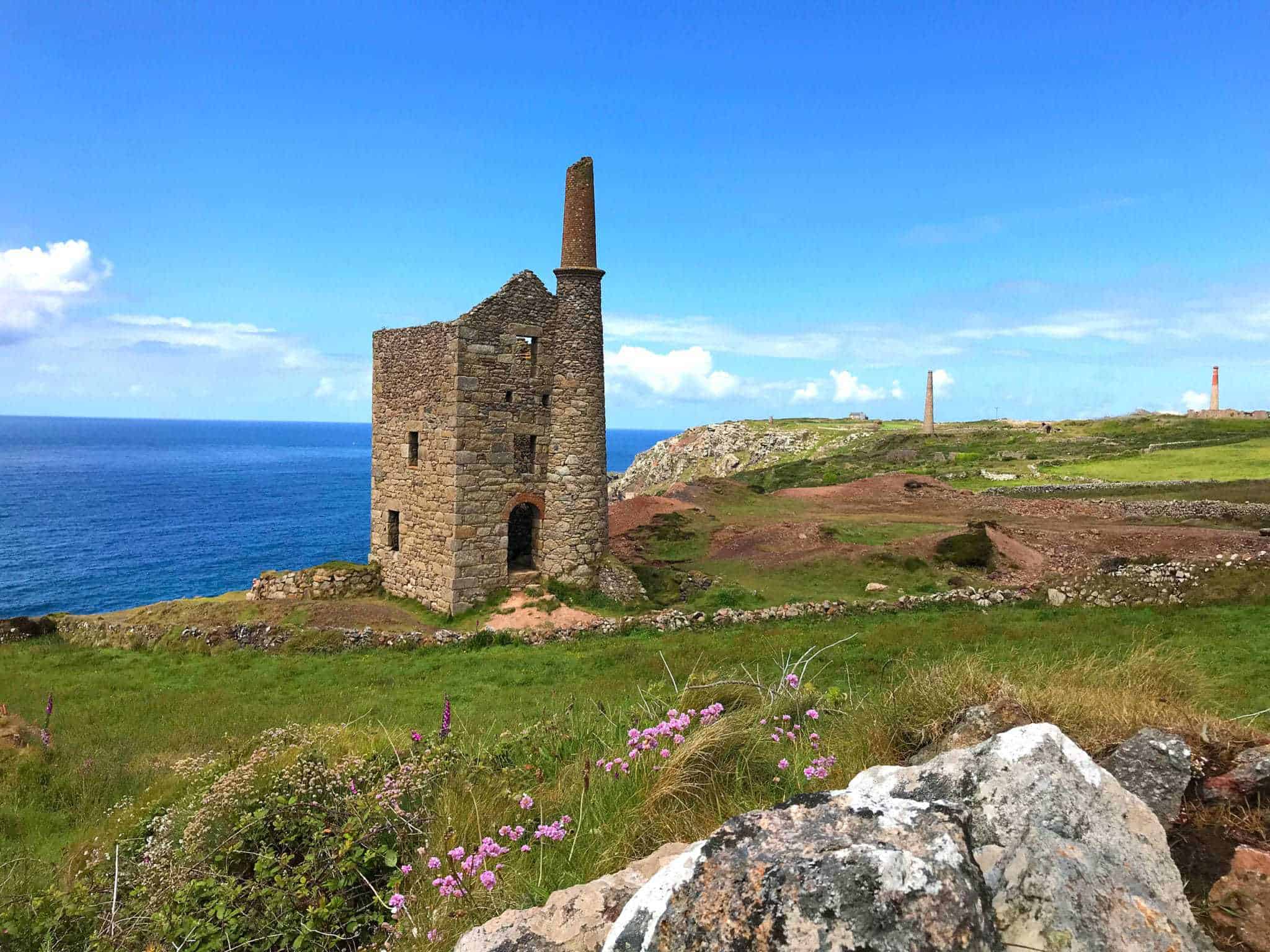



Tips for Making the Best Cornish Pasties
- A good, flaky shortcrust pastry is imperative, and I’m sharing my shortcrust recipe with you below that will ensure excellent results.
- Depending on how thin you roll out your shortcrust pastry you risk having the “hard” ingredients (the potatoes and rutabagas) pierce through the dough. If you prefer a thinner crust and you want to avoid that you can place the softer ingredients on the top and bottom with the harder ingredients sandwiched in the middle: Place the onions on the bottom followed by the potatoes and rutabagas and then the meat on top.
- Use firm, waxy potatoes so they hold their shape. Starchy potatoes will disintegrate during baking and turn mushy.
- Use a lean cut of beef. Traditional Cornish pasties use skirt steak from the underside belly of the cow because it’s lean and free of gristle.
- Add a couple of pats of butter on top of the filling ingredients followed by a light sprinkling of flour. This will both form the gravy as well as absorb the liquids from the vegetables as their cooking to avoid a soggy pastry crust.
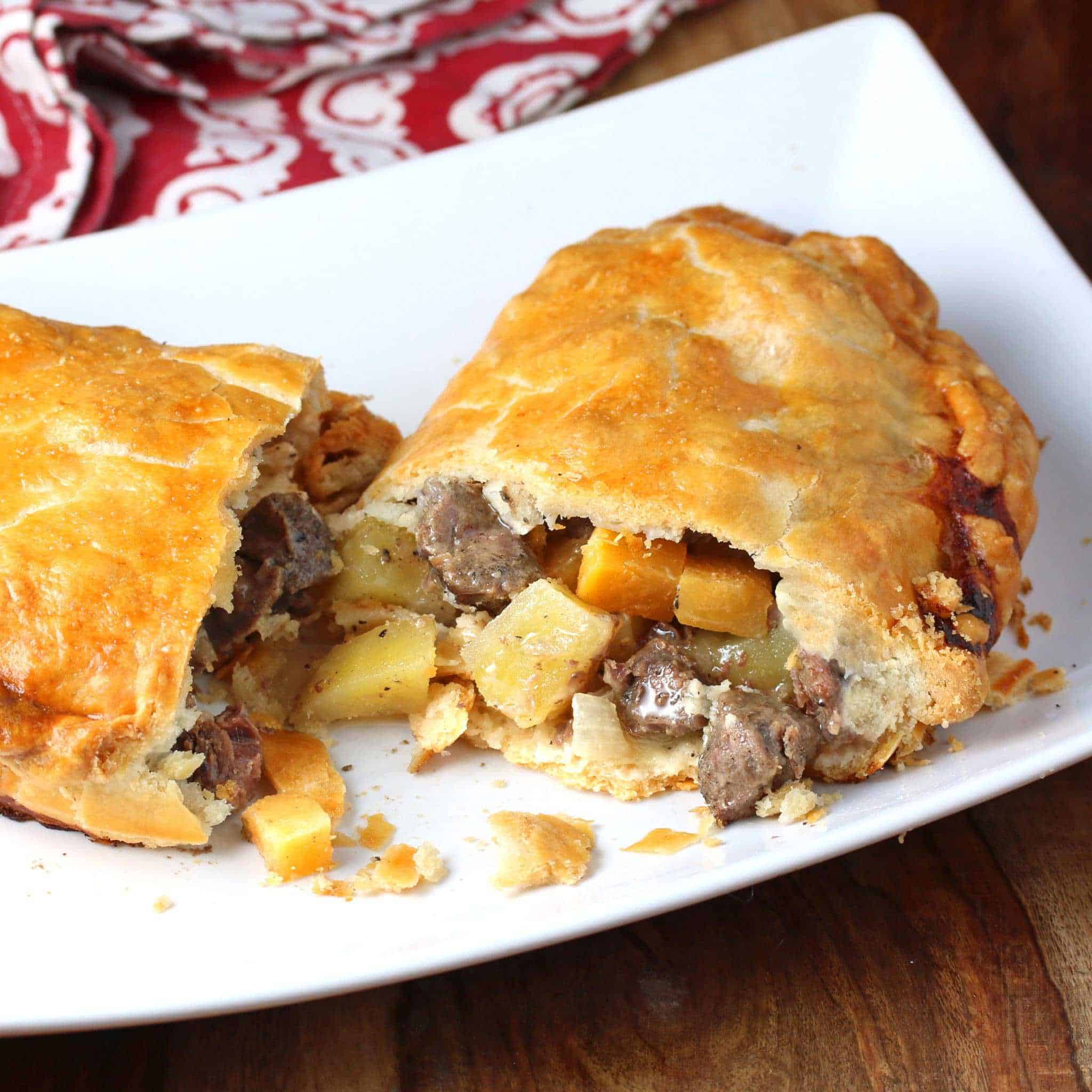
Cornish Pasty Recipe
Let’s get started!
First make your shortcrust pastry:
Place the flour and salt in a food processor and pulse a few times until combined. Add the cold butter and lard and pulse a few more times until the mixture resembles coarse crumbs.
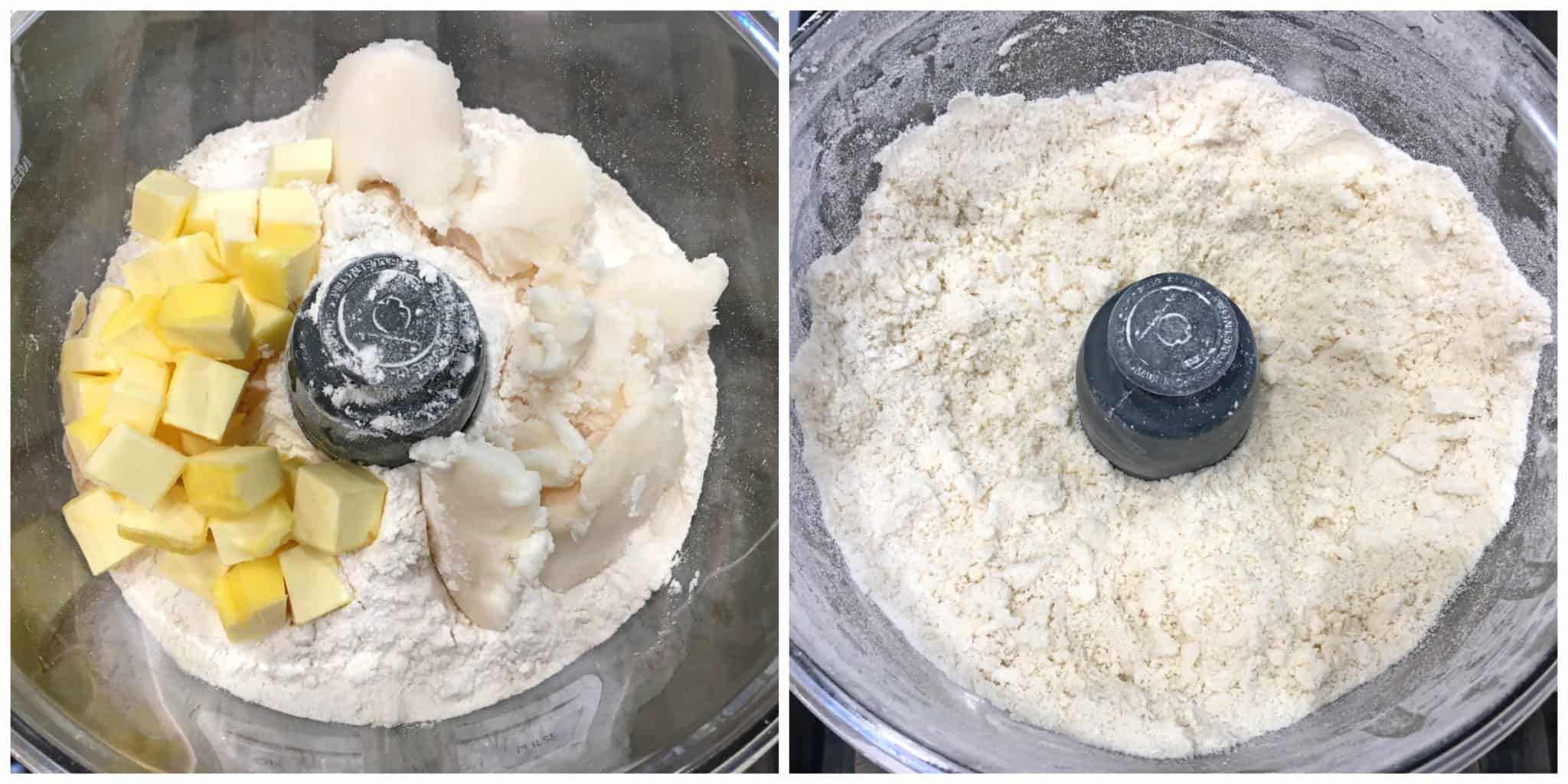
Add the water a little at a time, pulsing between additions, until the mixture begins to come together. DO NOT over-mix the dough or the pastry crust will be tough and won’t be flaky.
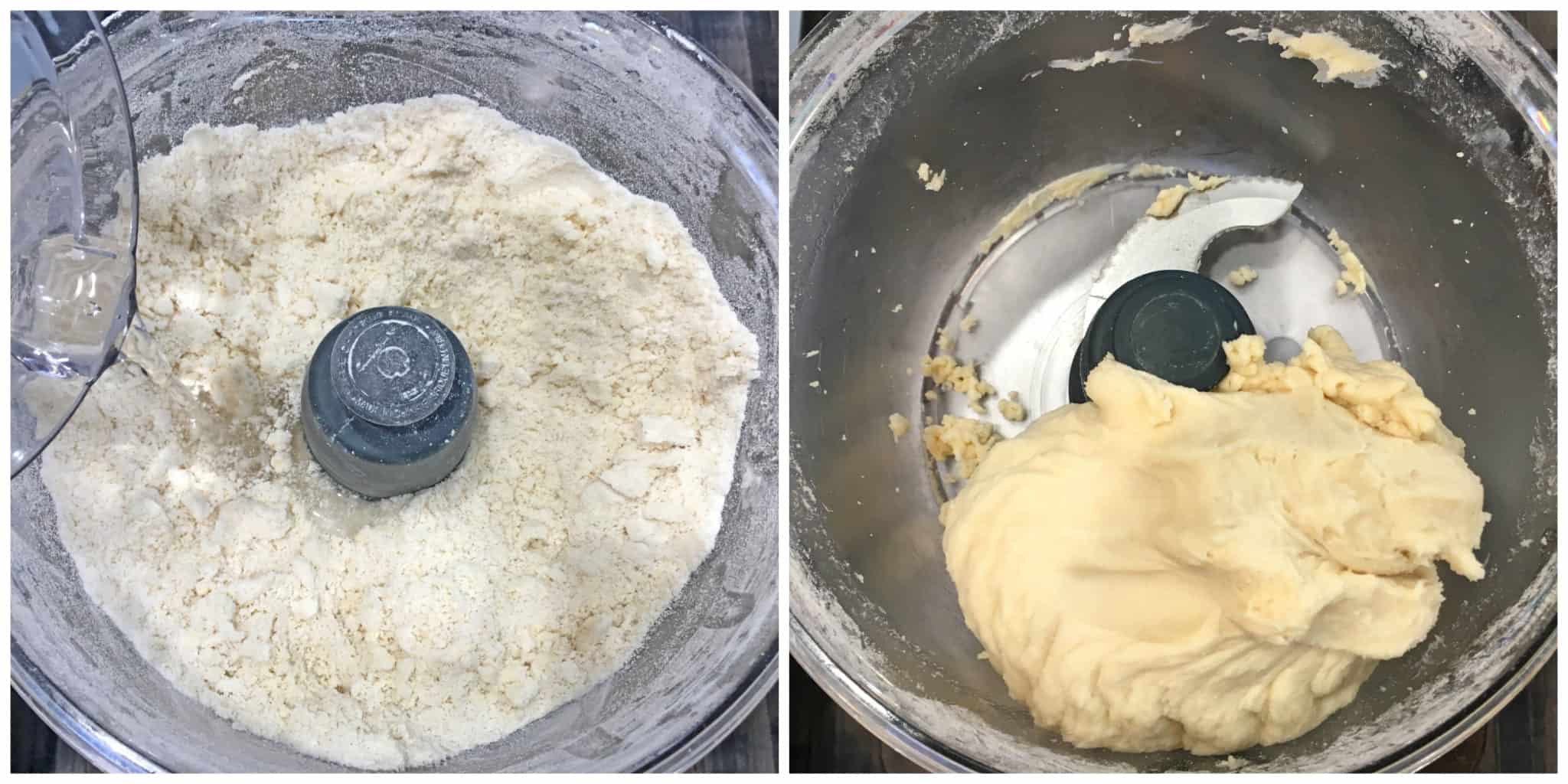
Form the dough into a ball, flatten into a 1-inch thick disk, wrap in plastic wrap and refrigerate for at least 3 hours before using (this is crucial). (Can be refrigerated for a few days or frozen for up to 3 months.)
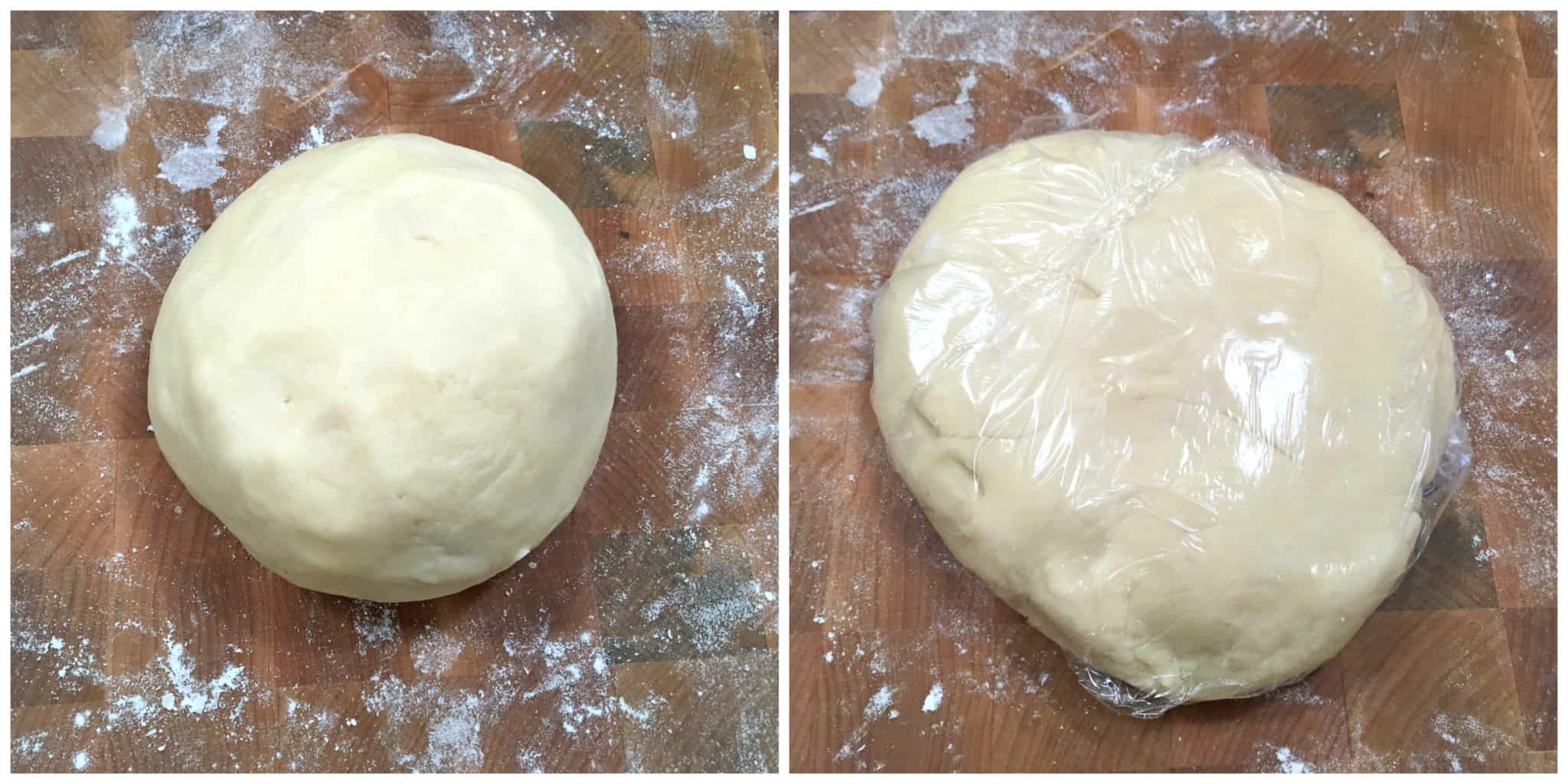
Roll the pastry dough into a log and cut it into 6 equal pieces.
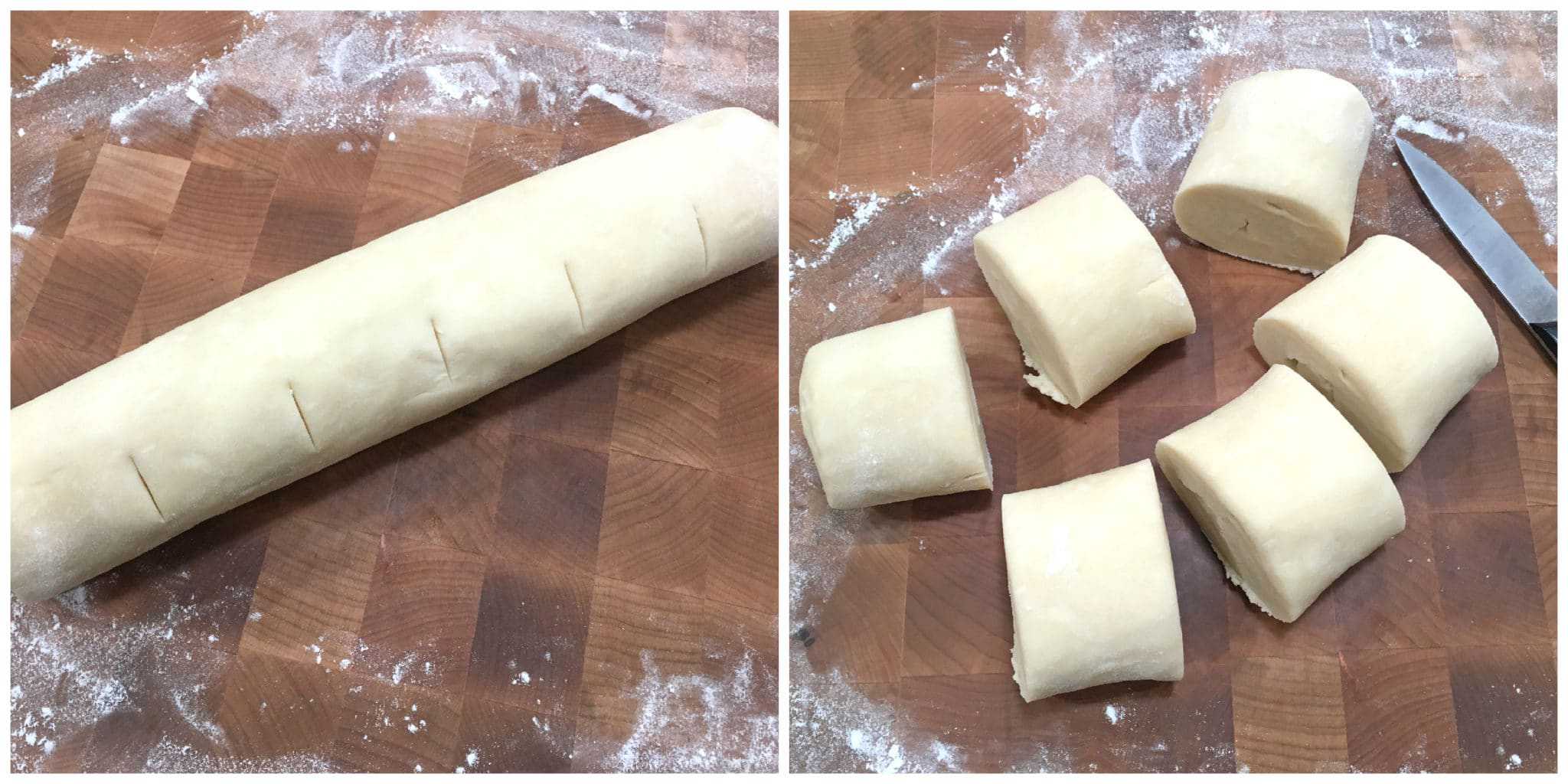
Wrap and keep the other 5 pieces chilled in the fridge while you’re working on one at a time. Roll the dough out on a lightly floured work surface to a 8 inch circle that’s about 1/8 inch thick. You can use an 8-inch plate as your guide and cut the dough around it to form your circle.
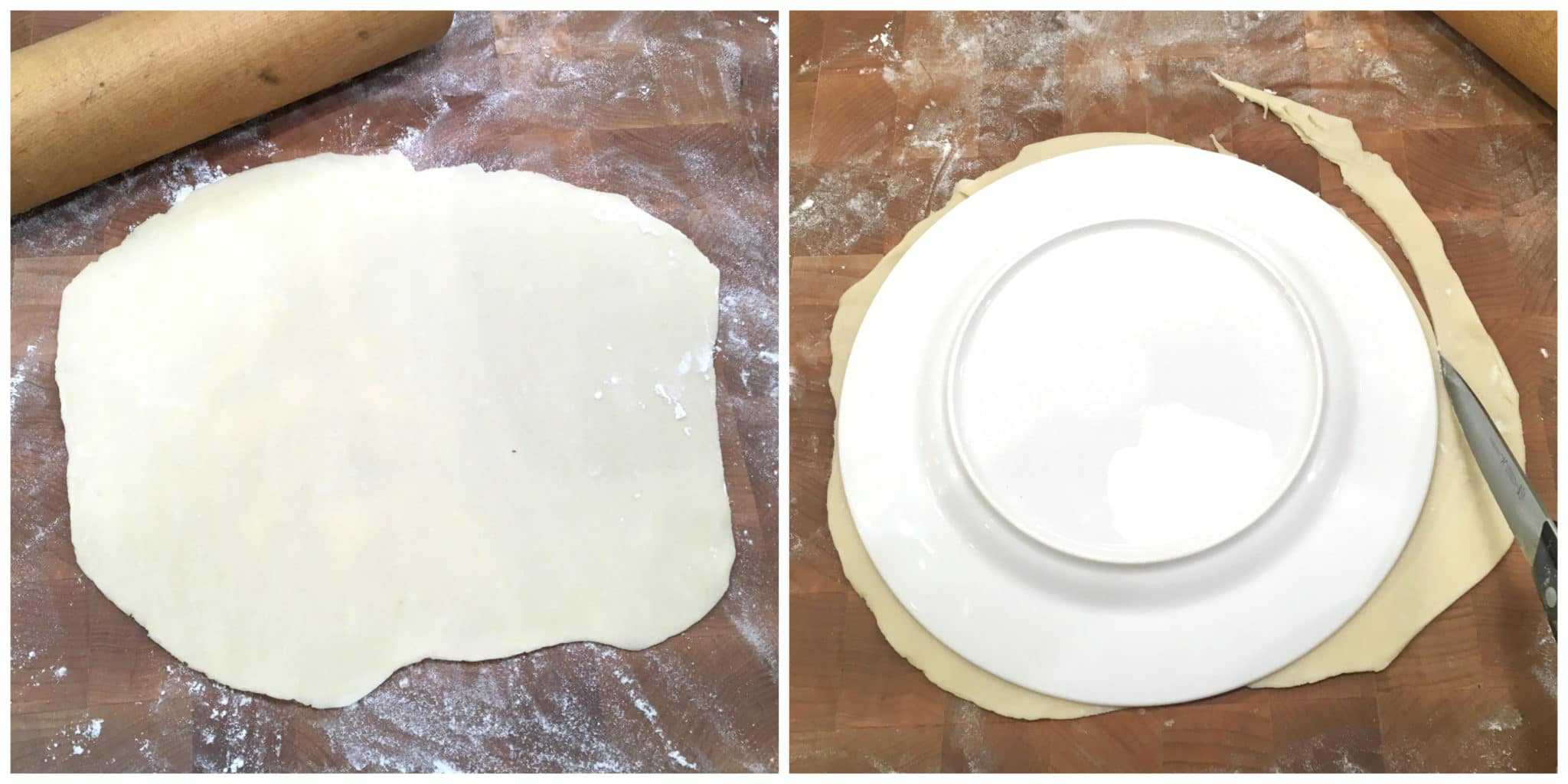
Layer the filling (each ingredient to be divided out between 6 pasties, there may be some excess remaining): Put layer of potatoes down the center of the pastry circle, leaving about 3/4 inch space on the top and bottom edges of the pastry dough. Lightly sprinkle with salt and pepper.
Next add a layer of rutabagas and sprinkle with salt and pepper.
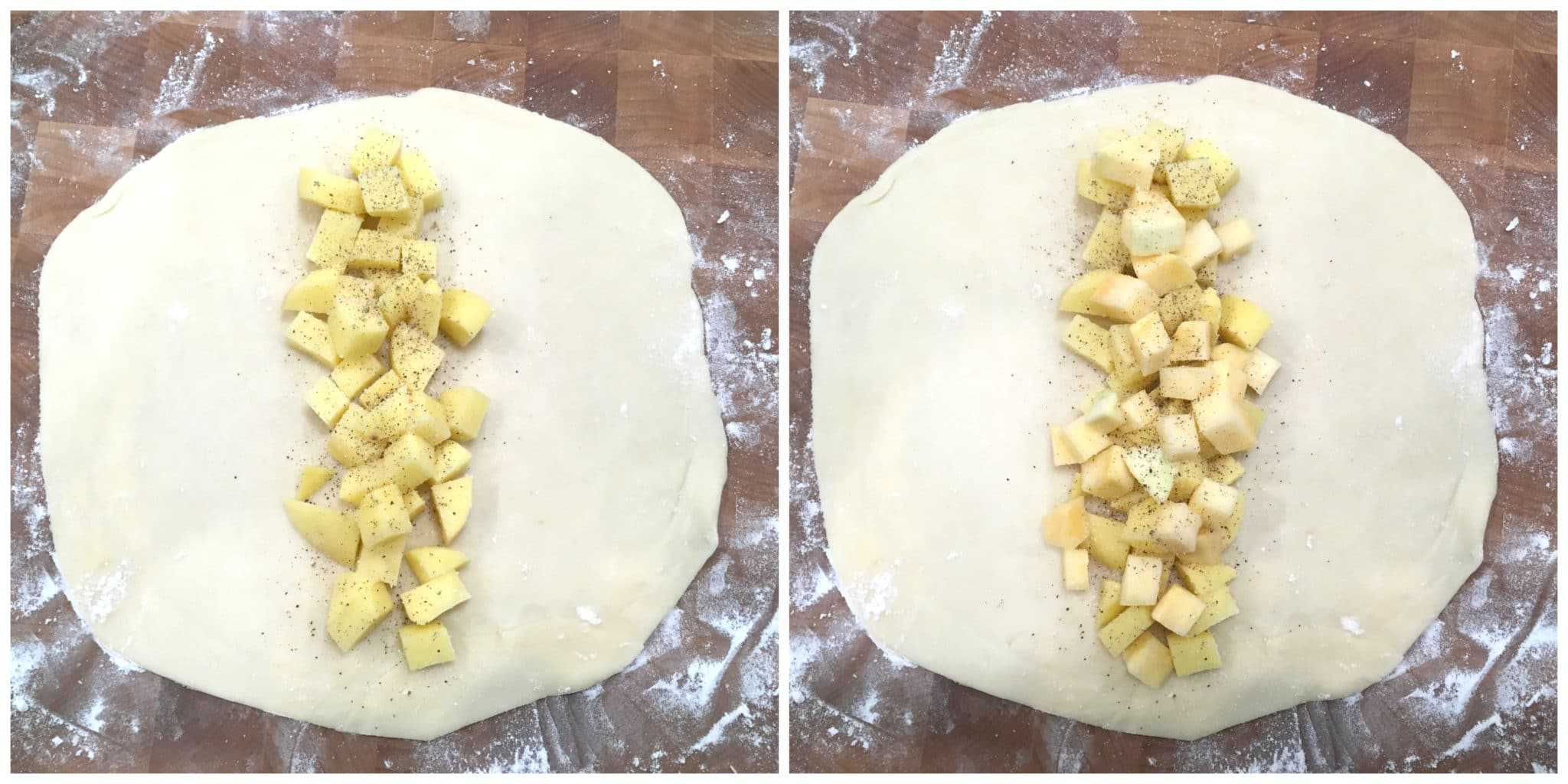
Add a layer of beef followed by the onions and sprinkle with salt and pepper.
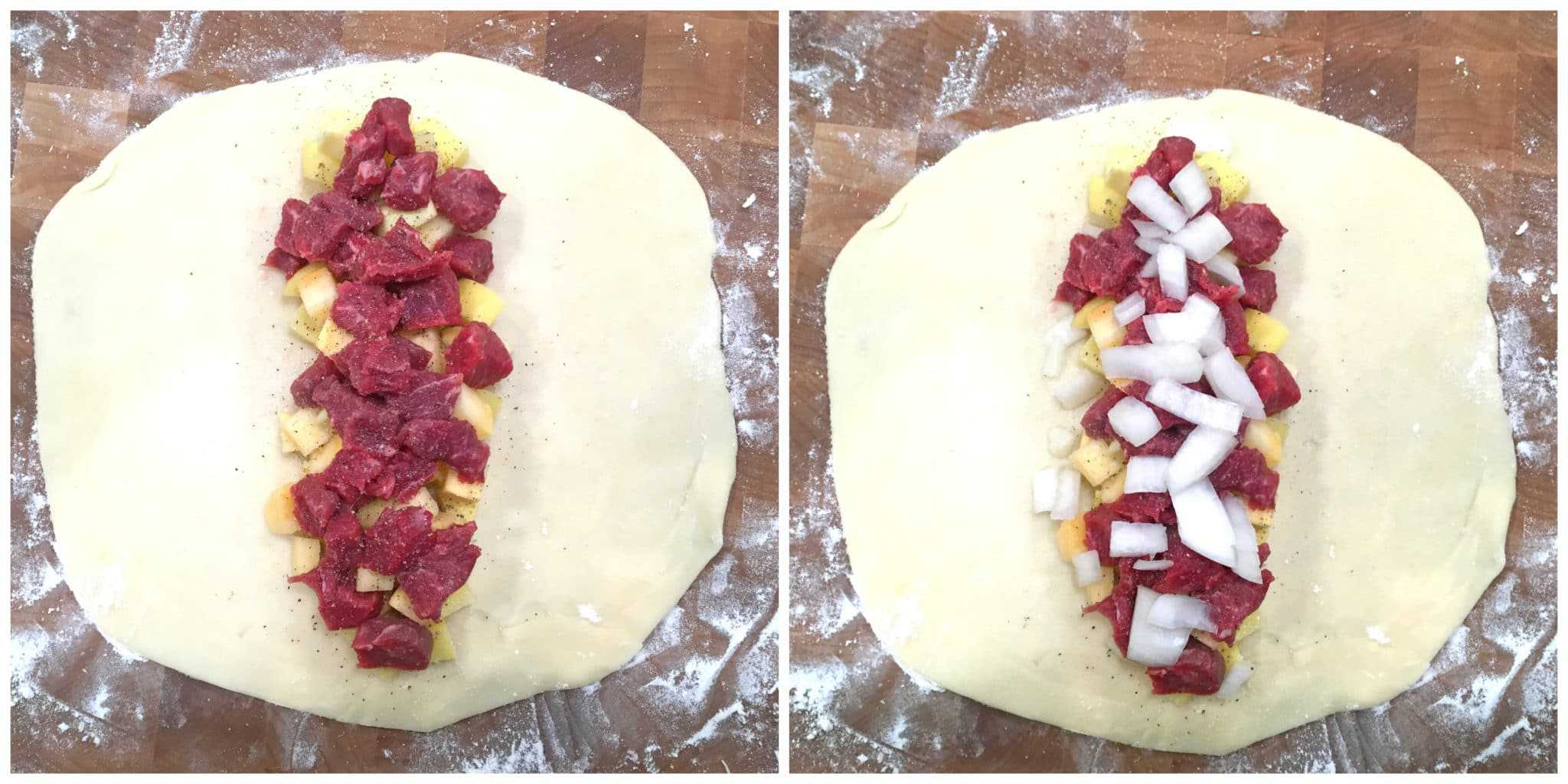
Lay a couple of pats of butter on top of the beef and sprinkle a little flour over the filling.
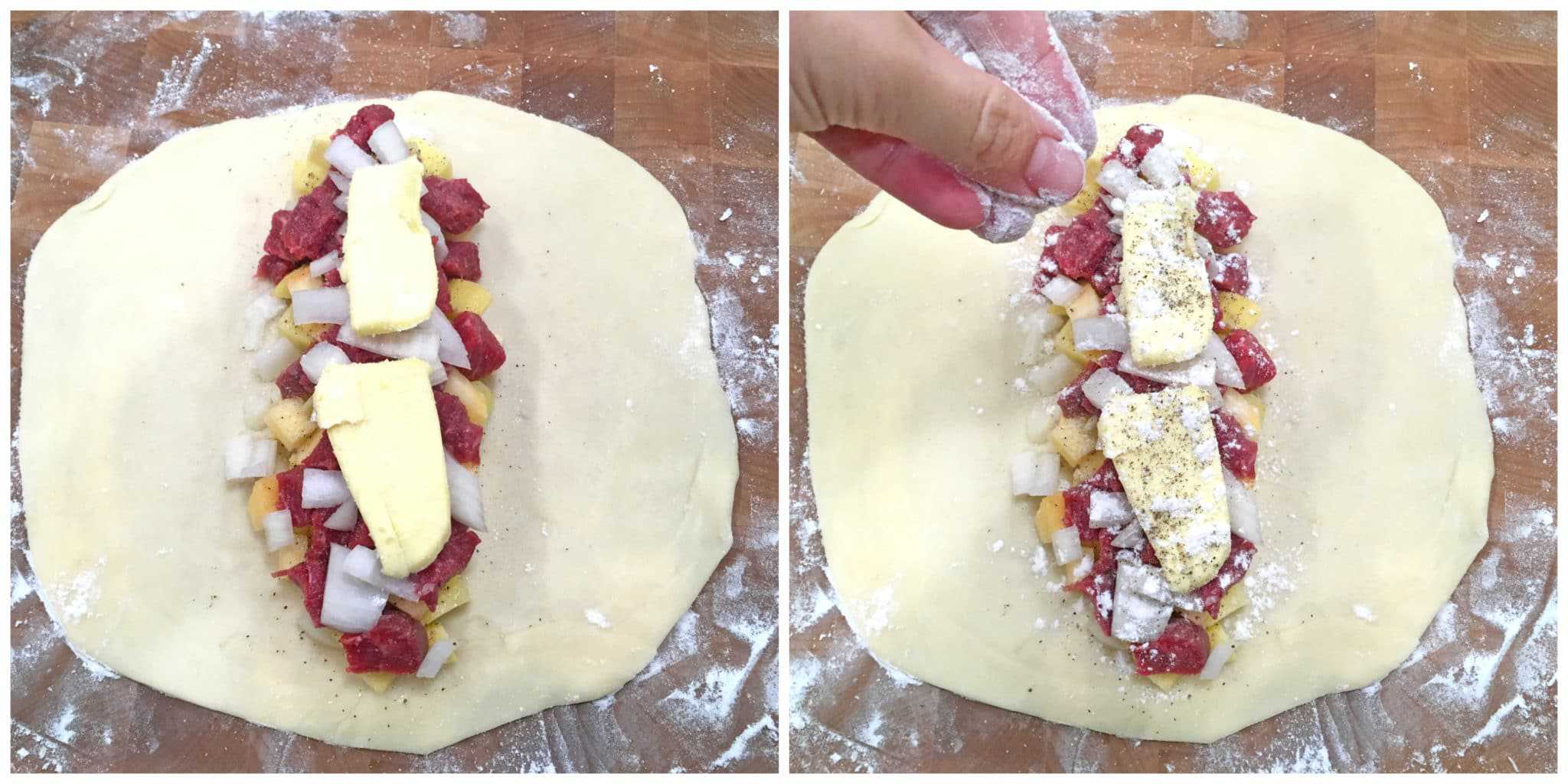
Wet the tips of your fingers and lightly moisten the edges of the pastry dough.
For the remaining steps work gently so that the filling doesn’t puncture through the dough. If this happens, patch up the hole with some of the scrap pieces of pastry dough. Bring the sides up and seal the pasty down the middle.
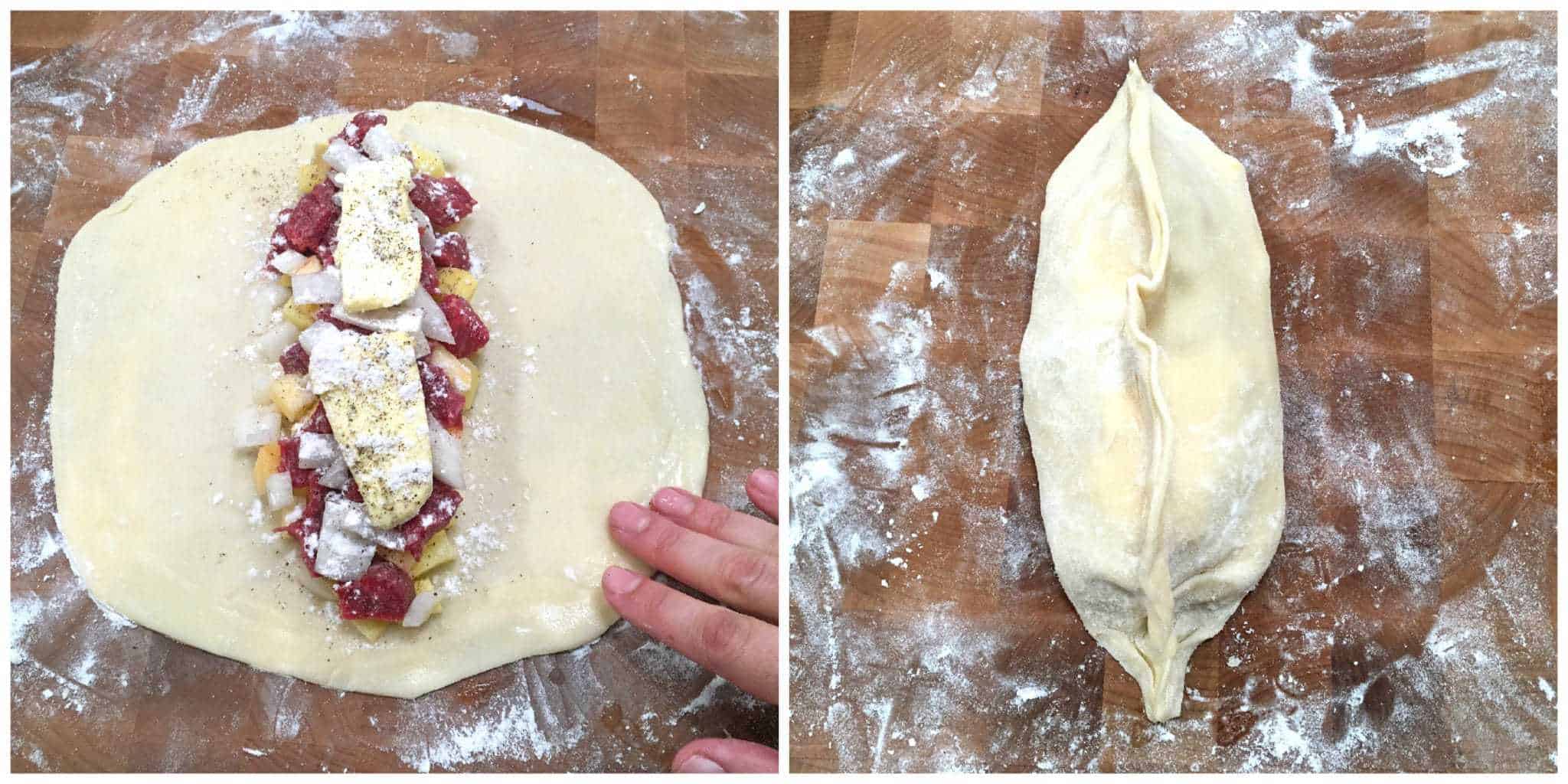
Turn the pasty onto its side and crimp/braid the edges in traditional Cornish fashion. This is the challenging part of making traditional Cornish pasties and takes some practice. There are some YouTube videos you can look up that show how to do this.
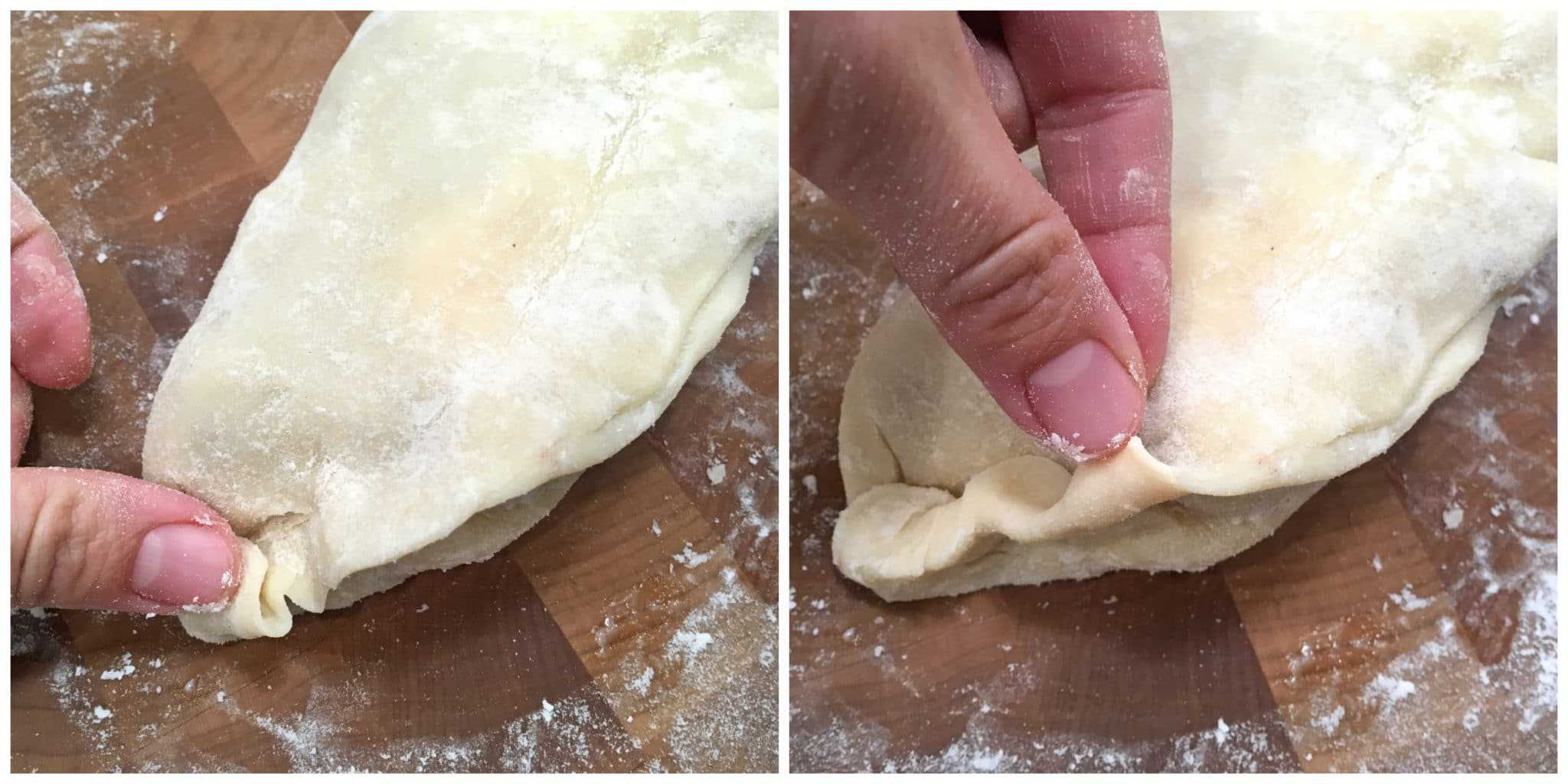
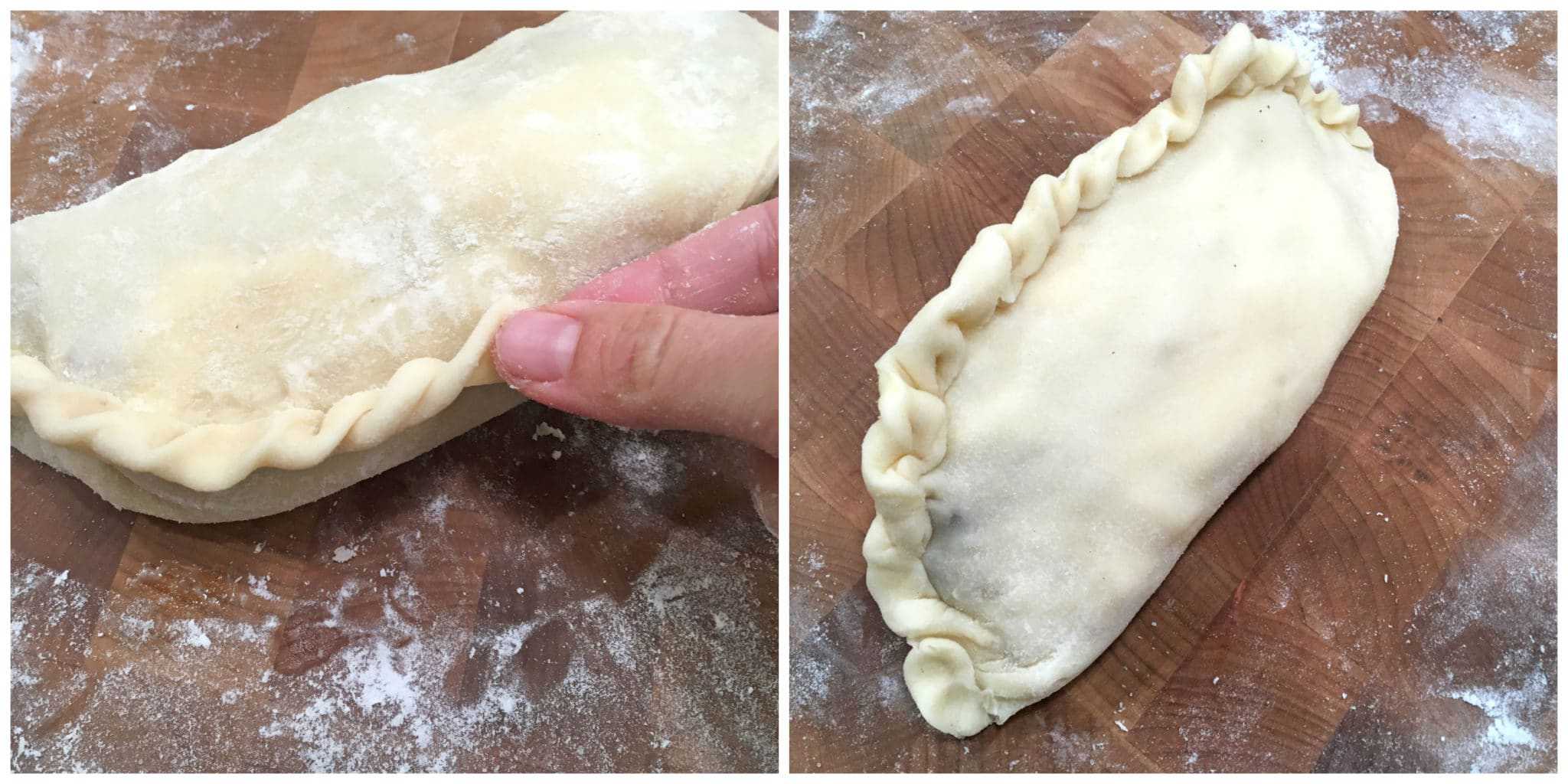
Assemble the remaining pasties and lay them on a lined baking sheet.
Use a sharp knife to cut a slit in the center of each pasty.
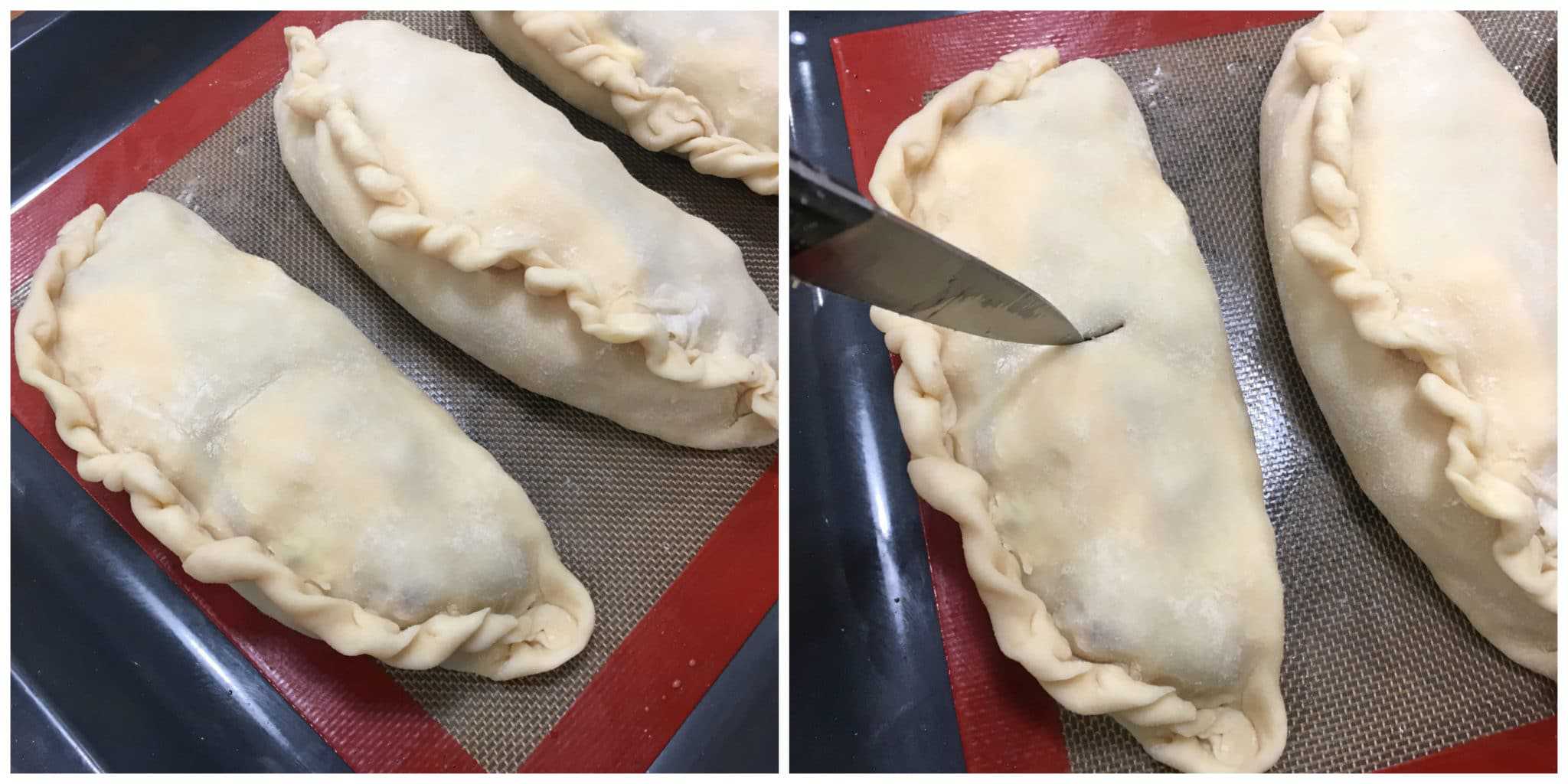
Lightly brush each pasty with the beaten egg mixture.
Bake the Cornish pasties on the middle rack for 40-50 minutes until golden in color. Remove from the oven and let them sit for about 10 minutes (they will be very hot inside) before eating.
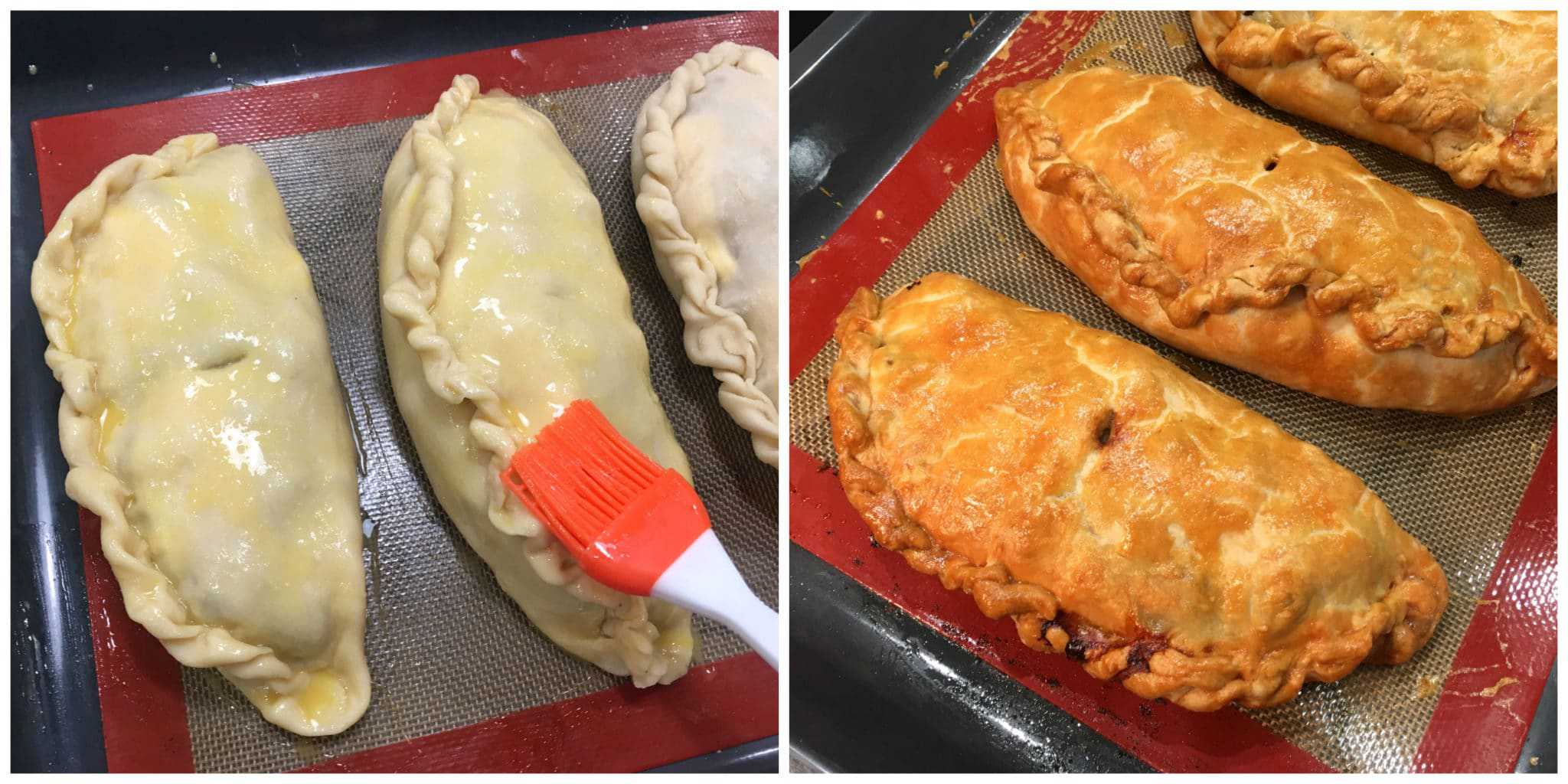
The homemade Cornish pasties can be reheated in the oven or in microwave, but for a crispy crust I highly recommend reheating them in the oven.

Can Cornish Pasties Be Frozen?
Yes. The shortcrust pastry holds up well to freezing and thawing and the filling has little liquid which means the pasties won’t get soggy. You can freeze them either baked or unbaked, whichever you prefer. Wrap each pasty individually in plastic wrap and then store the wrapped pasties in a heavy-duty freezer bag.
If you’re freezing them unbaked it’s best to cook them while frozen – don’t thaw them first. Baking time will take roughly 15-20 minutes longer.
If you’re freezing them already fully baked and cooled then you can simply reheat them in the oven (for a crispier crust) or in the microwave and you have a quick, ready-to-go meal.
Enjoy!
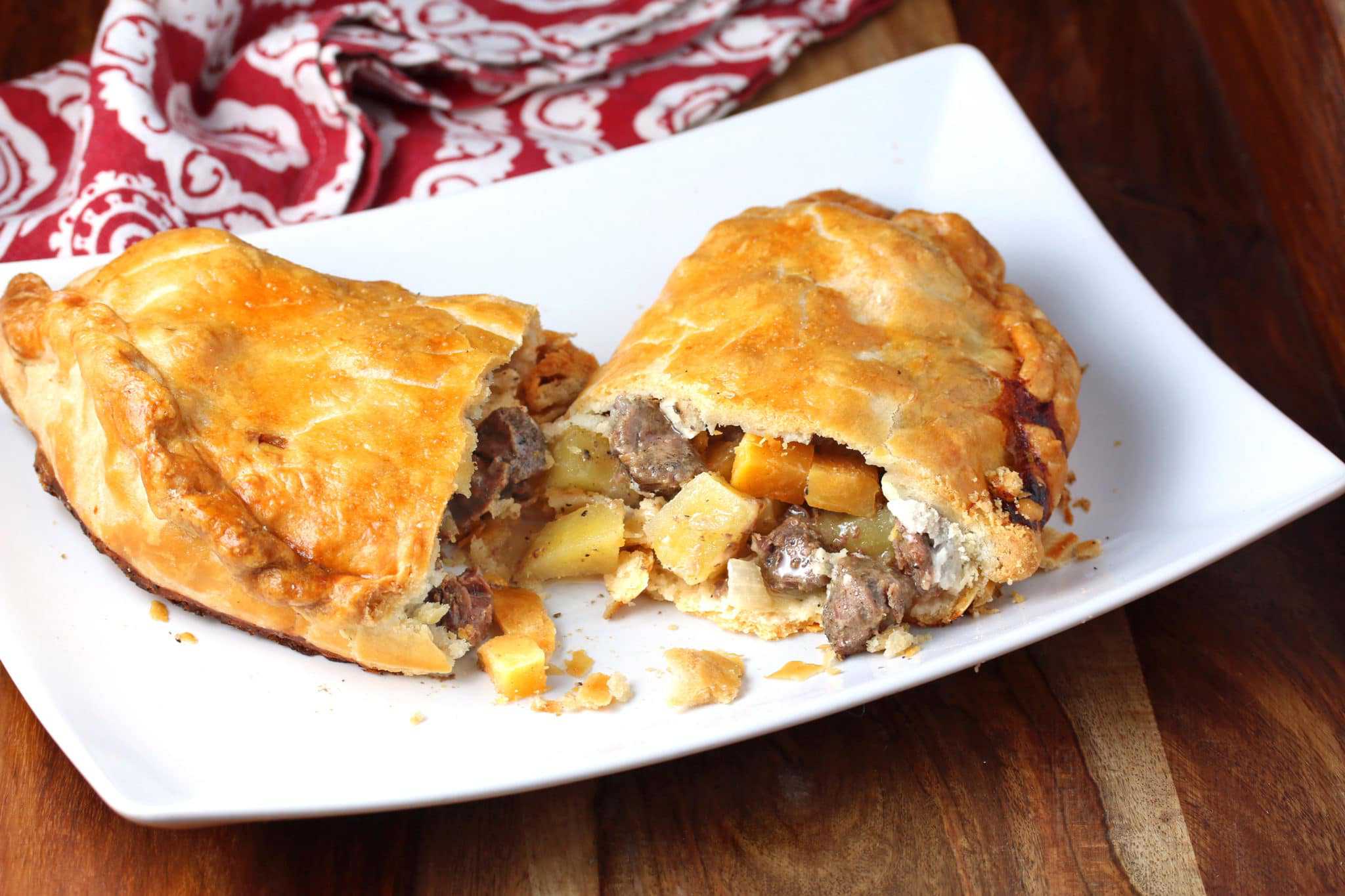
For more favorite British recipes try my:
- Fish and Chips
- Yorkshire Pudding
- Mushy Peas
- Bangers and Mash
- Scotch Eggs
- Crumpets
- Cornish Fairings
- Sticky Toffee Pudding
- Mincemeat Pie
- Beef and Guinness Stew
- Spotted Dick
- Chelsea Buns
- Toad in the Hole
- Eccles Cakes
- Scottish hortbread
- Treacle Tart
Save This Recipe
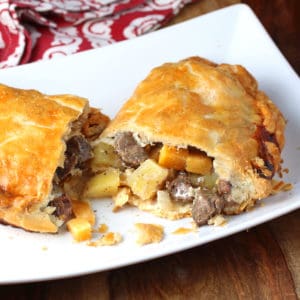
Authentic Cornish Pasty Recipe
Ingredients
For the Shortcrust Pastry:
- 3 1/2 cups all-purpose flour or bread flour (I make mine with all-purpose flour)
- 1 teaspoon salt
- 5 ounces unsalted butter , very cold, diced
- 5 ounces lard , very cold (can substitute butter but lard makes the flakiest crust)
- How to Render Lard (click link to learn how to make it yourself. It's super easy and much cheaper than store-bought!)
- 2/3 cup ice cold water
For the Cornish Pasties:
- 1 pound beef skirt steak or sirloin , cut into small cubes
- 1 pound firm, waxy potato (e.g. Yukon Gold) , peeled and diced in 1/4 inch cubes, or slice them according to personal preference (**starchy potatoes will disintegrate and turn mushy so be sure to use a firm, waxy potato that will hold its shape)
- 8 ounces rutabaga , peeled and diced in 1/4 inch cubes, or slice them according to personal preference
- 7 ounces yellow onion , chopped
- salt and pepper to taste
- unsalted butter (for cutting in slices to lay inside the pasties)
- all-purpose flour (for sprinkling inside the pasties)
- 1 large egg , lightly beaten
Instructions
- To Make the Shortcrust Pastry: Place the flour and salt in a food processor and pulse a few times until combined. Add the cold butter and lard and pulse a few more times until the mixture resembles coarse crumbs. Add the water a little at a time, pulsing between additions, until the mixture begins to come together. DO NOT over-mix the dough or the pastry crust will be tough and won't be flaky. Form the dough into a ball, wrap in plastic wrap, and refrigerate for at least 3 hours before using (this is crucial). (Can be refrigerated for a few days or frozen for up to 3 months.)
- To Make the Cornish Pasties: Preheat the oven to 350 degrees F.Cut it into 6 equal pieces (rolling the dough into a log and then cutting makes this easier). Wrap and keep the other 5 pieces chilled in the fridge while you're working on one at a time. Roll the dough out on a lightly floured work surface to a 8 inch circle that's about 1/8 inch thick. You can use an 8-inch plate as your guide and cut the dough around it to form your circle.
- Layer the filling (see note at end): Put layer of potatoes down the center of the pastry circle, leaving about 3/4 inch space on the top and bottom edges of the pastry dough. Lightly sprinkle with salt and pepper. Next add a layer of rutabagas, onions and finally the beef, adding a light sprinkling of salt and pepper between each layer. Lay a couple pats of butter on top of the beef and sprinkle a little flour over the filling.
- Wet the tips of your fingers and lightly moisten the edges of the pastry dough. For this next part work gently so that the filling doesn't puncture through the dough. If this happens, patch up the hole with some of the scrap pieces of pastry dough. Bring the sides up and seal the pasty down the middle. Turn the pasty onto its side and crimp the edges in traditional Cornish fashion (see blog post pictures as a visual).
- Assemble the remaining pasties and lay them on a lined baking sheet. Use a sharp knife to cut a slit in the center of each pasty. Lightly brush each pasty with the beaten egg mixture.
- Bake the Cornish pasties on the middle rack for 40-50 minutes until golden in color. Remove from the oven and let them sit for about 10 minutes (they will be very hot inside) before eating. They can be reheated in the oven (recommended for a crispier crust) or microwave. NOTE: Depending on how full you stuff the pasties you may have leftover filling. No worries, just fry it up together or add it to soup and enjoy it as a separate meal.
Nutrition
Originally published on The Daring Gourmet January 22, 2020



















I decided to make this recipe in honor of my Grandma. She would make these every year when we had finished getting all of the root vegetables out of the garden. I added carrots , the memories came flooding back with the first bite!
Thanks for this wonderful recipe that helped me here nor her memory
That’s wonderful, Michael, I’m sure your grandma would be proud. Thanks so much for the feedback – I’m happy you enjoyed the pasties and the stroll down memory lane.
You recipe was absolutely amazing. Thank you so much. My family loved them.
Fantastic, Lisa, thank you so much!
Fantastic recipe, absolutely delicious. Really clear method, well done keep up the good work. 👍
Thanks so much, Nick, I’m happy you enjoyed it and appreciate the feedback!
Lovely, best pasty I have had. Previous were in Devon and Cornwall, hand made in a couple of pubs.
Thank you.
Thank you so much, Angela! :)
Living in the Westcountry I have always had a weakness for pasties but I have never had much success making them. Determined to right that wrong, I used your recipe. Hooray, finally I managed decent pasties. Now I have 2 uncooked ones in the freezer and 3 cooked ones. I ate the other one because they smelled s delicious when they came out of the oven.
The recipe has been printed and added to my file of favourites. These will definitely be made again and again.
Thank you for a great recipe.
Friendly greetings to the Westcountry, Barbara! Thank you so much for the compliment, I’m thrilled they were a success! :)
Great recipe I love baking and will use your site in future. Everything is self explanatory thank you
Thank you so much, Julie!
Thank you so much for the recipe. I am french and I was looking for a Cornish pasties recipe and yours looked clearer.
I have a question. Could I serve it for a lunch, if yes, with what ?
I want to invite English guests, and I want to be sure to do exactly the right thing.
Thank you for your help.
And “un grand bravo” for your site.
Hi Samah, pasties are pretty much a complete meal and are generally eaten alone with nothing more than some chutney or piccalilli to accompany them. If you’re going to serve something with them I would make it something light like a simple salad (no additional heavy carbs like potatoes or fries). Happy cooking! :)
Have bo idea what to rate the receipt as i gave up. Whoever designed your web site needs shooting, the text kept resising EveRY Few Seconds and the receipt was so far after other stuff of no interest. Will not be coming back to this site
So let me make sure I understand this. You came to my site to get a FREE recipe at no cost to yourself other than the effort it took to click on the “Jump to Recipe” button at the very top of the page which allowed you to go straight to the recipe (did I mention the recipe is FREE, along with nearly 1000 other recipes I offer completely for FREE?)….and yet…you think I should be SHOT? You have a serious problem, David. And I don’t mean just spelling and grammar problems, though those could certainly use some help too. Really, get a grip.
Agreed! Some people need something to complain about! Thank you for the recipe. I just shake my head🤨 Love the recipe! Wondering if I can freeze them and do I bake them before freezing
Hi Sharon! Yes, they can be frozen. You can freeze them either baked or unbaked, whichever you prefer. Wrap each pasty individually in plastic wrap and then store the wrapped pasties in a heavy-duty freezer bag. If you’re freezing them unbaked it’s best to cook them while frozen – don’t thaw them first. Baking time will take roughly 15-20 minutes longer. If you’re freezing them already fully baked and cooled then you can simply reheat them in the microwave or, for crispier crust, reheat them in the oven.
Well said. Why don’t ppl open their eyes . love the recipe.
Great recipe I love baking and will use your site.in future everything self explanatory thank you
There is no reason to be so rude. It was probably your computer.
I made these for Christmas dinner and they came out just perfect. I was quite nervous about making the pastry, but it was very forgiving and came out tender and flakey. I used the leftover meat and vegetables for a delicious hash- frying the root vegetables first, removing them from the skillet, then caramelizing the onions, then adding the meat, and re-adding the root vegetables.
Wonderful, Laurel, thank you so much for the feedback!
If you want authentic Cornish pasties then make sure that your crimp is larger than those shown. A pasty is designed to be eaten while using the crimp as a handle.
I’m from the Upper Peninsula of Michigan, so I’m an official Yooper.
Pasties are also the official food of the U.P.
Back in the day when the Mines were running, wives would make pasties for their working husbands out of necessity and convenience.
They would eat their lunch with one hand, as they did not have utensils on the job not a way to reheat their lunch. Pasties are still a huge deal here. I can tell you I have eaten at least…200 in my lifetime. I bet more;)
I just made my annual batch to keep throughout the winter months.
Mine are better then my Mother in laws..🤫
I used this recipe and my MIL’s, they are in the oven as I type!
I followed the recipe to a t and turned out well. The next time I grated the lard and the butter before mixing and was so much easier. After mixing and before putting into the fridge I took the ball of dough and shaped into the log right away as this reduced the working time with the dough. Thanks for the great recipe!
Thank you, Pam, I’m so glad you enjoyed it!
Just wondering…Is there a reason for making the dough into a ball and then a flattened disc, only to remove it from the refrigerator and then roll into a log? Why not roll into a log from the beginning, before refrigerating?
I think the dough just naturally forms a ball after mixing, that is how you know it is done mixing.
My husband is a Killebrew too. We were watching Great British bake-off and the bakers were assigned to make a Cornish pasty so my internet search led to your recipe and story. So now we must make it and try to be true to our roots.
Wonderful, Teresa! And without a doubt we’re related. We’ve done a lot of family history research (and we recently moved to Virginia where the first Killigrews-turned-Killebrew landed and settled) – it would be interesting to know who our common ancestor is. Happy baking and I hope you both enjoy the pasties!
I live in Plymouth Devon on the Devon/Cornwall border and interestingly there has been found an early reference, 16th Century, in the Plymouth record office suggesting they may have come from Devon.
http://news.bbc.co.uk/1/hi/england/cornwall/6144460.stm https://www.theguardian.com/uk/2006/nov/12/foodanddrink
Pasties like the right way to eat a scone have fueled many a friendly argument in the West Country.
Oh by the way nice recipe :-)
Looks like I’m not he only one led here from GBBS! I’m not from or live anywhere exciting – I’m in San Diego, CA but excited to try this! I actually suck at baking but hey why not!
Okay my real question is – my best friend is gluten free so I’ll sub gluten free flour for hers. . . Have you ever made it GF? Wondering if cook times would be effected? Thank you!!
If you want to make smaller ones do you reduce baking time or temp? Thanks!